Influences of Multilayer Graphene and Boron Decoration on the Structure and Combustion Heat of Al3Mg2 Alloy
Abstract
:1. Introduction
2. Materials and Methods
2.1. Materials
2.2. Synthesis of Materials
2.3. Apparatus and Measurements
3. Results
3.1. Nitrogen Adsorption-Desorption Isotherm Test with Multilayer Graphene
3.2. Structure Tests with the Al3Mg2 Alloy
3.3. TG–DSC Tests with Amorphous Boron
3.4. Raman Tests with Multilayer Graphene
3.5. SEM Tests on Boron-Decorated and Multilayer Graphene-Decorated Al3Mg2 Alloys
3.6. Combustion Properties of Al3Mg2, the Boron-Decorated Al3Mg2 Alloy, and the Multilayer Graphene-Decorated Al3Mg2 Alloy
4. Conclusions
Author Contributions
Funding
Acknowledgments
Conflicts of Interest
References
- Liu, J.; Xi, J.-F.; Yang, W.; Hu, Y.-R.; Zhang, Y.-W.; Wang, Y.; Zhou, J. Effect of magnesium on the burning characteristics of boron particles. Acta Astronaut. 2014, 96, 89–96. [Google Scholar] [CrossRef]
- Zarezadeh Mehrizi, M.; Beygi, R.; Eisaabadi, B.G.; Velashjerdi, M.; Nematzadeh, F. Mechanically activated combustion synthesis of Ti3AlC2/Al2O3 nanocomposite from TiO2/Al/C powder mixtures. Adv. Powder Technol. 2019, 30, 311–316. [Google Scholar] [CrossRef]
- Luigi, T.; Deluca, T.S.; Valery, P.; Max Calabro, S. Chenical Rocket Propulsion; Springer International Publishing Switzerland: Cham, Switzerland, 2017; p. 289. [Google Scholar]
- Pang, W.-Q.; DeLuca, L.T.; Fan, X.-Z.; Glotov, O.G.; Wang, K.; Qin, Z.; Zhao, F.-Q. Combustion behavior of AP/HTPB/Al composite propellant containing hydroborate iron compound. Combust. Flame 2020, 220, 157–167. [Google Scholar] [CrossRef]
- Cheng, Z.; Chu, X.; Zhao, W.; Yin, J.; Dai, B.; Zhong, H.; Xu, J.; Jiang, Y. Controllable synthesis of Cu/Al energetic nanocomposites with excellent heat release and combustion performance. Appl. Surf. Sci. 2020, 513, 145704. [Google Scholar] [CrossRef]
- Stamatis, D.; Wainwright, E.R.; Lakshman, S.V.; Kessler, M.S.; Weihs, T.P. Combustion of explosively dispersed Al-Mg-Zr composite particles. Combust. Flame 2020, 217, 93–102. [Google Scholar] [CrossRef]
- Tanga, D.-Y.; Fana, Z.-M.; Yangb, G.; Wangc, Y.; Liua, P.-J.; Yana, Q.-L. Combustion performance of composite propellants containing core-shell Al@M(IO3) metastable composites. Combust. Flame 2020, 219, 33–43. [Google Scholar] [CrossRef]
- Korotkikh, A.G.; Glotov, O.G.; Arkhipov, V.A.; Zarko, V.E.; Kiskin, A.B. Effect of iron and boron ultrafine powders on combustion of aluminized solid propellants. Combust. Flame 2017, 178, 195–204. [Google Scholar] [CrossRef]
- Kim, K.J.; Cho, M.H.; Kim, J.H.; Kim, S.H. Effect of paraffin wax on combustion properties and surface protection of Al/CuO-based nanoenergetic composite pellets. Combust. Flame 2018, 198, 169–175. [Google Scholar] [CrossRef]
- Song, J.-X.; Guo, T.; Yao, M.; Chen, J.-L.; Ding, W.; Bei, F.-L.; Zhang, X.-N.; Yin, Q.; Huang, J.-Y.; Li, C.-H. Thermal and combustion behavior of Al-MnO2 nanothermite with poly(vinylidene fluoride -co- hexafluoropropylene) energetic binder. Def. Technol. 2020. [Google Scholar] [CrossRef]
- Deng, S.; Jiang, Y.; Huang, S.; Shi, X.; Zhao, J.; Zheng, X. Tuning the morphological, ignition and combustion properties of micron-Al/CuO thermites through different synthesis approaches. Combust. Flame 2018, 195, 303–310. [Google Scholar] [CrossRef]
- Islam, M.R.; Obaid, J.E.; Saiduzzaman, M.; Nishat, S.S.; Debnath, T.; Kabir, A. Effect of Al doping on the structural and optical properties of CuO nanoparticles prepared by solution combustion method: Experiment and DFT investigation. J. Phys. Chem. Solids 2020, 147, 109646. [Google Scholar] [CrossRef]
- Feng, Y.; Ma, L.; Xia, Z.; Huang, L.; Yang, D. Ignition and combustion characteristics of single gas-atomized Al–Mg alloy particles in oxidizing gas flow. Energy 2020, 196, 117036. [Google Scholar] [CrossRef]
- Nie, H.; Pisharath, S.; Hng, H.H. Combustion of fluoropolymer coated Al and Al–Mg alloy powders. Combust. Flame 2020, 220, 394–406. [Google Scholar] [CrossRef]
- Dou, Z.-H.; Zhang, T.-A.; Shi, G.-Y.; Peng, C.; Wen, M.; He, J.-C. Preparation and characterization of amorphous boron powder with high activity. Trans. Nonferrous Met. Soc. China 2014, 24, 1446–1451. [Google Scholar] [CrossRef]
- Hashim, S.A.; Karmakar, S.; Roy, A.; Srivastava, S.K. Regression rates and burning characteristics of boron-loaded paraffin-wax solid fuels in ducted rocket applications. Combust. Flame 2018, 191, 287–297. [Google Scholar] [CrossRef]
- Zhou, W.; Yetter, R.; Dryer, F.; Rabitz, H.; Brown, R.; Kolb, C. Multi-phase model for ignition and combustion of boron particles. Combust. Flame 1999, 117, 227–243. [Google Scholar] [CrossRef]
- Wang, J.; Zeng, C.; Zhan, C.; Zhang, L. Tuning the reactivity and combustion characteristics of PTFE/Al through carbon nanotubes and grapheme. Thermochim. Acta 2019, 676, 276–281. [Google Scholar] [CrossRef]
- Bao, L.; Zhang, W.; Zhang, X.; Chen, Y.; Chen, S.; Wu, L.; Shen, R.; Ye, Y. Impact of MWCNT/Al on the combustion behavior of hydroxyl ammonium nitrate (HAN)-based electrically controlled solid propellant. Combust. Flame 2020, 218, 218–228. [Google Scholar] [CrossRef]
- Huang, T.; Mao, S.; Pu, H.; Wen, Z.; Huang, X.; Ci, S.; Chen, J. Nitrogen-doped graphene–vanadium carbide hybrids as a high-performance oxygen reduction reaction electrocatalyst support in alkaline media. J. Mater. Chem. A 2013, 1, 13404. [Google Scholar] [CrossRef]
- Wu, G.; Xu, B.-Q. Carbon nanotube supported Pt electrodes for methanol oxidation: A comparison between multi- and single-walled carbon nanotubes. J. Power Sources 2007, 174, 148–158. [Google Scholar] [CrossRef]
- Shen, M.; Ruan, C.; Chen, Y.; Jiang, C.; Ai, K.; Lu, L. Covalent entrapment of cobalt–iron sulfides in N-doped mesoporous carbon: Extraordinary bifunctional electrocatalysts for oxygen reduction and evolution reactions. ACS Appl. Mater. Interfaces 2015, 7, 1207–1218. [Google Scholar] [CrossRef] [PubMed]
- Zhang, Z.; Su, L.; Yang, M.; Hu, M.; Bao, J.; Wei, J.; Zhou, Z. A composite of Co nanoparticles highly dispersed on N-rich carbon substrates: An efficient electrocatalyst for Li–O2 battery cathodes. Chem. Commun. 2014, 50, 776–778. [Google Scholar] [CrossRef]
- Scudino, S.; Sperling, S.; Sakaliyska, M.; Thomas, C.; Feuerbacher, M.; Kim, K.; Ehrenberg, H.; Eckert, J. Phase transformations in mechanically milled and annealed single-phase β-Al3Mg2. Acta Mater. 2008, 56, 1136–1143. [Google Scholar] [CrossRef]
- Huang, T.; Yu, J.; Han, J.; Zhang, Z.; Xing, Y.; Wen, C.; Wu, X.; Zhang, Y. Oxygen reduction catalytic characteristics of vanadium carbide and nitrogen doped vanadium carbide. J. Power Sources 2015, 300, 483–490. [Google Scholar] [CrossRef]
- Jain, H.G.; Karacuban, H.; Krix, D.; Becker, H.W.; Nienhaus, H.; Buck, V. Carbon nanowalls deposited by inductively coupled plasma enhanced chemical vapor deposition using aluminum acetylacetonate as precursor. Carbon 2011, 49, 4987–4995. [Google Scholar] [CrossRef]
- Chuang, A.T.; Boskovic, B.O.; Robertson, J. Freestanding carbon nanowalls by microwave plasma-enhanced chemical vapour deposition. Diam. Relat. Mater. 2006, 15, 1103–1106. [Google Scholar] [CrossRef]
- Tuinstra, F.; Koenig, J.L. Raman spectrum of graphite. J. Chem. Phys. 1970, 53, 1126–1130. [Google Scholar] [CrossRef] [Green Version]
- Chintersingh, K.-L.; Schoenitz, M.; Dreizin, E. Boron doped with iron: Preparation and combustion in air. Combust. Flame 2019, 200, 286–295. [Google Scholar] [CrossRef]
- Chintersingh, K.-L.; Schoenitz, M.; Dreizin, E. Oxidation kinetics and combustion of boron particles with modified surface. Combust. Flame 2016, 173, 288–295. [Google Scholar] [CrossRef]
- Shabouei, M.; Subber, W.; Williams, C.W.; Matouš, K.; Powers, J.M. Chemo-thermal model and Gaussian process emulator for combustion synthesis of Ni/Al composites. Combust. Flame 2019, 207, 153–170. [Google Scholar] [CrossRef]
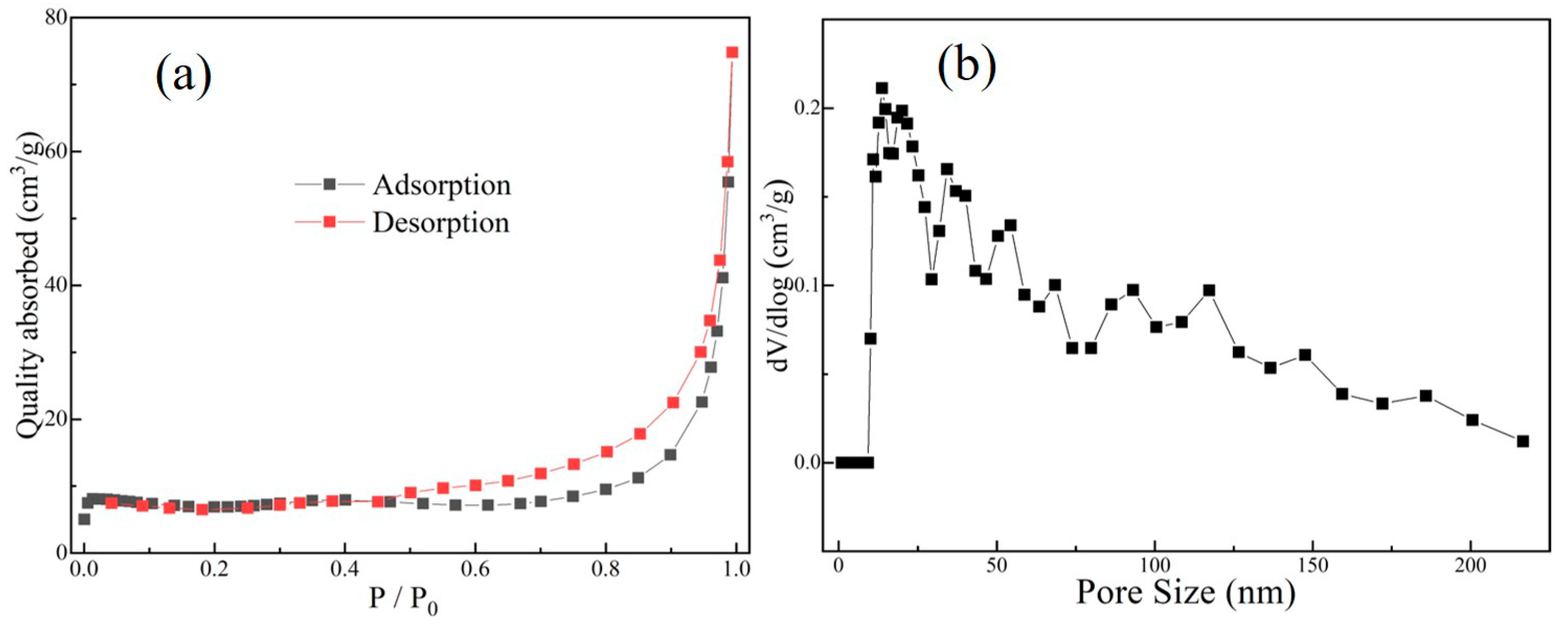
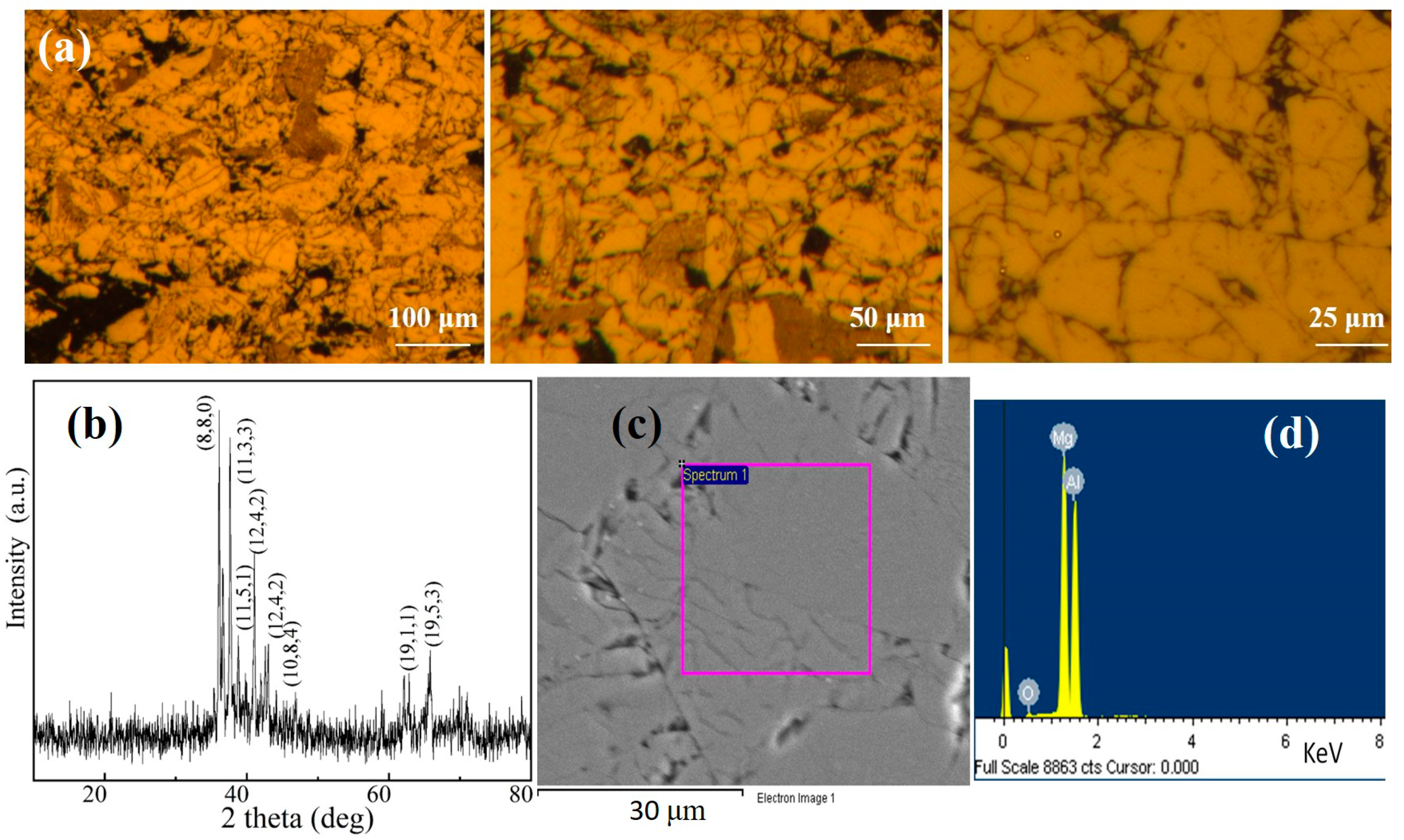
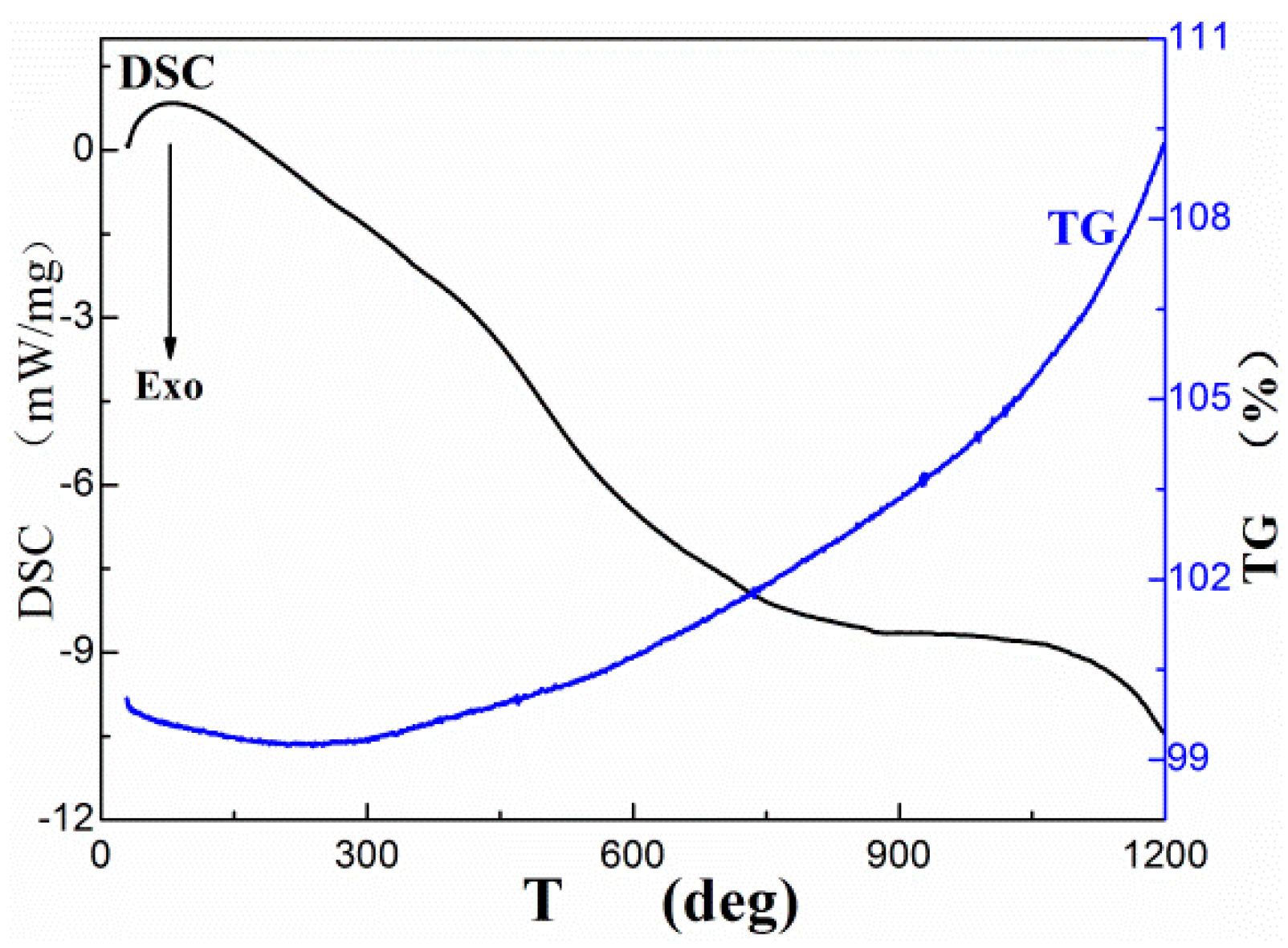
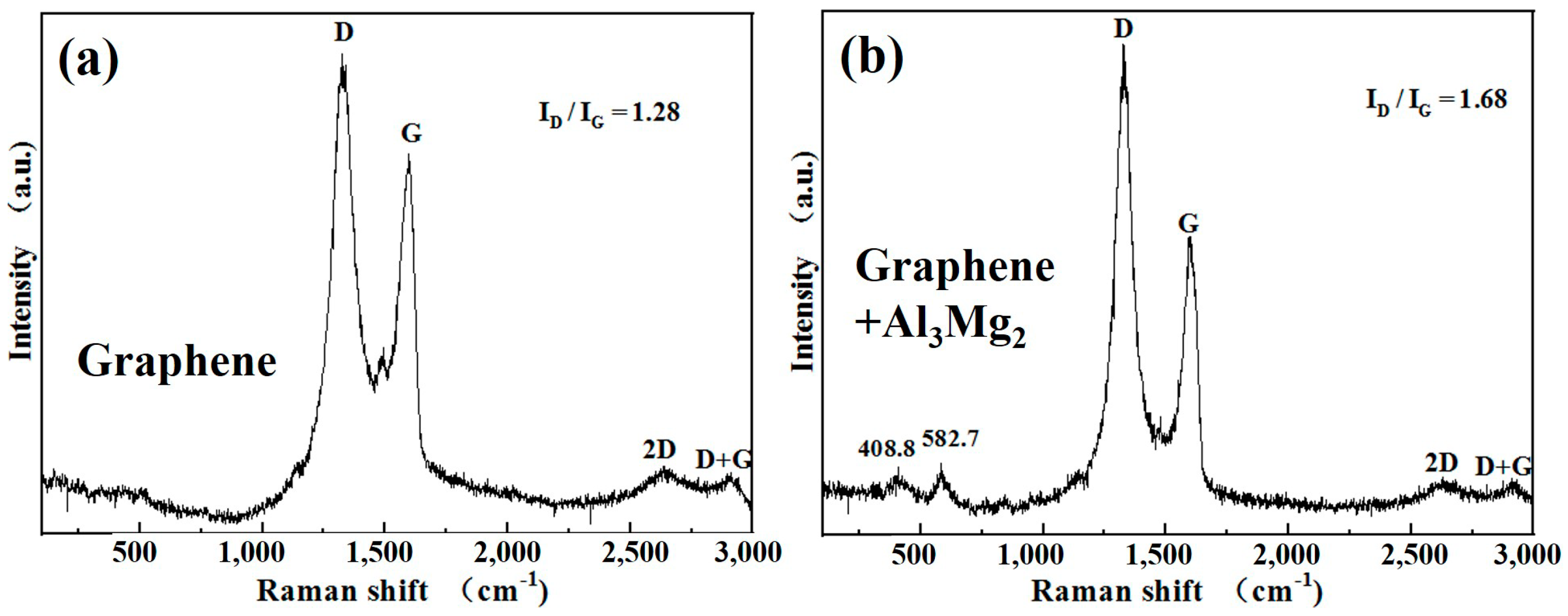

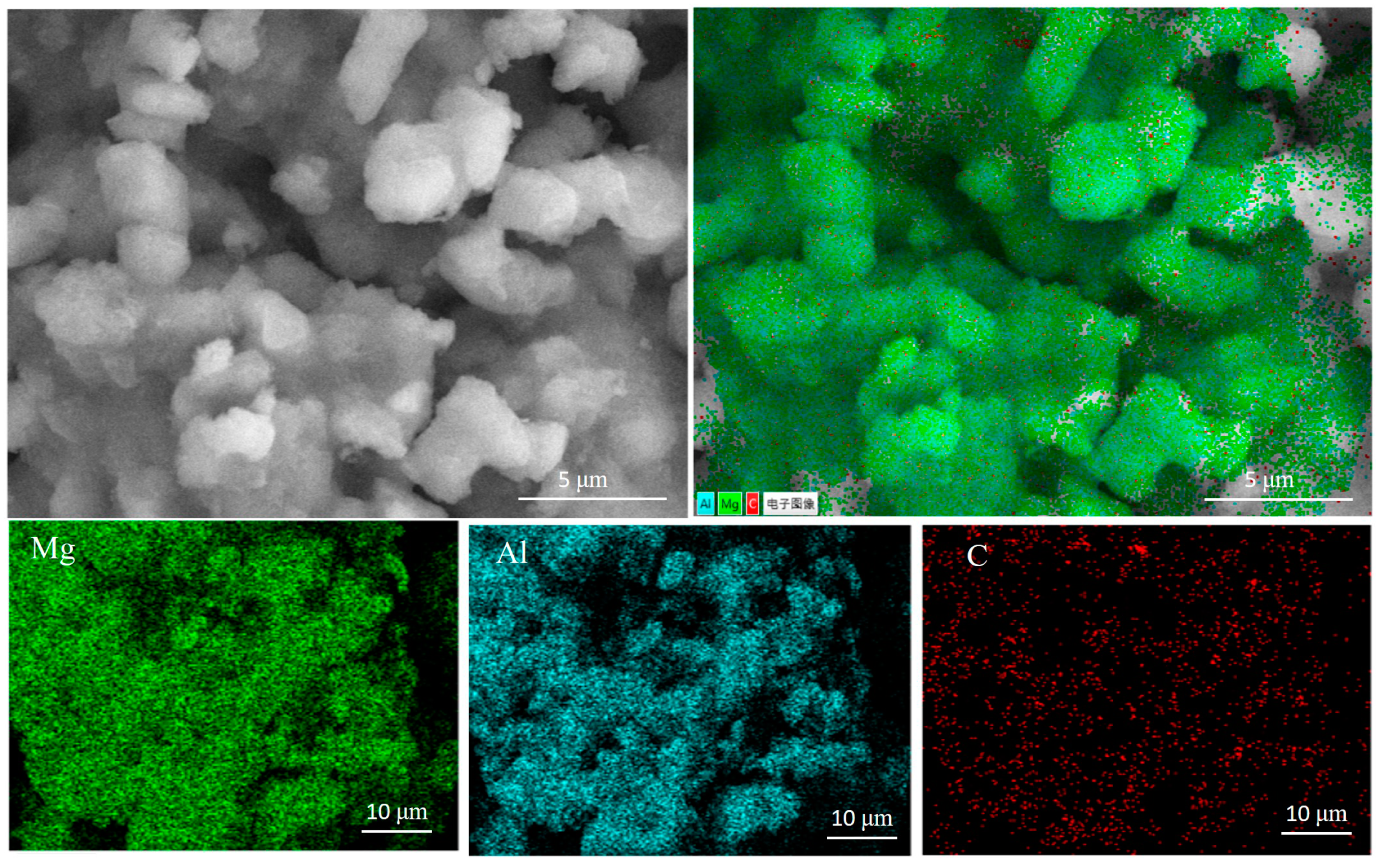
© 2020 by the authors. Licensee MDPI, Basel, Switzerland. This article is an open access article distributed under the terms and conditions of the Creative Commons Attribution (CC BY) license (http://creativecommons.org/licenses/by/4.0/).
Share and Cite
Dong, J.; Wang, W.; Wang, X.; Qiu, S.; Du, M.; Tan, B.; Yang, Y.; Huang, T. Influences of Multilayer Graphene and Boron Decoration on the Structure and Combustion Heat of Al3Mg2 Alloy. Nanomaterials 2020, 10, 2013. https://doi.org/10.3390/nano10102013
Dong J, Wang W, Wang X, Qiu S, Du M, Tan B, Yang Y, Huang T. Influences of Multilayer Graphene and Boron Decoration on the Structure and Combustion Heat of Al3Mg2 Alloy. Nanomaterials. 2020; 10(10):2013. https://doi.org/10.3390/nano10102013
Chicago/Turabian StyleDong, Jun, Weili Wang, Xiaofeng Wang, Shaojun Qiu, Maohua Du, Bo Tan, Yanjing Yang, and Taizhong Huang. 2020. "Influences of Multilayer Graphene and Boron Decoration on the Structure and Combustion Heat of Al3Mg2 Alloy" Nanomaterials 10, no. 10: 2013. https://doi.org/10.3390/nano10102013
APA StyleDong, J., Wang, W., Wang, X., Qiu, S., Du, M., Tan, B., Yang, Y., & Huang, T. (2020). Influences of Multilayer Graphene and Boron Decoration on the Structure and Combustion Heat of Al3Mg2 Alloy. Nanomaterials, 10(10), 2013. https://doi.org/10.3390/nano10102013





